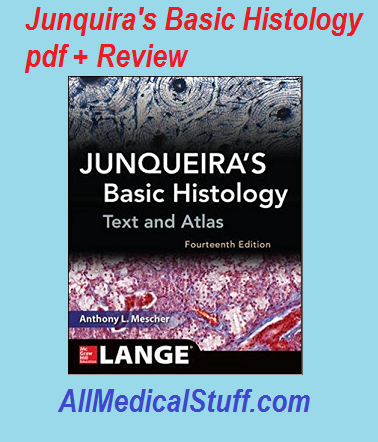Download Basic Histology Junqueira Pdf Free

Mescher, PhD is Professor of Anatomy and Cell Biology at the Indiana University School of Medicine Bloomington, Indiana.B.S., 1971, Biology, St. Joseph’s College, Rensselaer, IndianaM.S., 1973, Developmental Biology, The Ohio State University, Columbus, OhioPh.D., 1975, Developmental Biology, The Ohio State University, Columbus, Ohio, Thesis Director: Dr. Roy TassavaNIH trainee, Summer 1973, Fertilization and Gamete Physiology Training Program, Marine Biological Laboratory, Woods Hole, MassachusettsAmerican Cancer Society Post-doctoral Fellow, 1975-76, laboratory of Dr. Denis Gospodarowicz, The Salk Institute of Biological Studies, La Jolla, CaliforniaWorkshop in Molecular Biology, July 1991, Indiana University School of MedicineUser Reviews. Wow, this is an excellent book. The level of detail is spot-on, the diagrams are some of the best I’ve seen, and the photographs are vivid, clear, and large enough to appreciate minor details. This was a great book for my coursework and a nice review resource for STEP 1 preparation.
Junqueira's Basic Histology Test Bank Pdf
Concise descriptions and very nice illustrations. This book is only 527 pages, not more than 1000 pages as advertised.Table of ContentsListed below are all the chapters and units in the Junqueira’s Basic Histology: Text and Atlas, Fourteenth Edition PDF.1. Histology and Its Methods of StudyPreparation of Tissues for StudyLight MicroscopyElectron MicroscopyAutoradiographyCell & Tissue CultureHistochemistry & CytochemistryDetection Methods Using Specific Interactions Between MoleculesProblems in the Study of Tissue Sections2. The CytoplasmCell DifferentiationCytoplasmic OrganellesThe CytoskeleteonInclusions3. The Cell NucleusComponents of the NucleusCell DivisionThe Cell CycleStem Cells and Tissue RenewalMeiosisApoptosis4. Epithelial TissueCharacteristic Features of Epithelial CellsSpecializations of the Apical Cell SurfaceTypes of EpitheliaTransport Across EpitheliaRenewal of Epithelial Cells5. Connective TissueCells of Connective TissueFibersGround SubstanceTypes of Connective Tissue6.
Adipose TissueWhite Adipose TissueBrown Adipose Tissue7. CartilageHyaline CartilageElastic CartilageFibrocartilageCartilage Formation, Growth and Repair8. BoneBone CellsBone MatrixPeriosteum & EndostreumTypes of BoneOsteogenesisBone Growth, Remodeling, & RepairMetabolic Role of BoneJoints9. Nerve Tissue & The Nervous SystemDevelopment of Nerve TissueNeuronsGlial Cells & Neuronal ActivityCentral Nervous SystemPeripheral Nervous SystemNeural Plasticity & Regeneration10.

Muscle TissueSkeletal MuscleCardiac MuscleSmooth MuscleRengeneration of Muscle Tissue11. The Circulatory SystemHeartTissues of the Vascular WallStructural Plan of Blood VesselsVasculatureLymphatic Vascular System12. BloodComposition of PlasmaBlood Cells13. HemopoiesisStem Cells, Growth Factors, & DifferentiationBone MarrowMaturation of ErythrocytesMaturation of GranulocytesMaturation of AgranulocytesOrigin of Platelets14. The Immune System & Lymphoid OrgansAntigensAntibodiesCytokinesCells of the Immune SystemTypes of Immune ResponsesLymphoid TissuesThymusMusoca-Associated Lymphoid Tissue (MALT)Lymph NodesSpleen15. Digestive TractGeneral Structure of the Digestive TractOral CavityEsophagusStomachSmall IntestineLarge Intestine16.
Organs Associated with the Digestive TractSalivary GlandsPancreasLiverHepatic Lobule Structure & FunctionBiliary Tract & Gallbladder17. The Respiratory SystemRespiratory EpitheliumNasal CavitiesSinuses & NasopharynxLarynxTracheaBronchial Tree & LungPulmonary Vasculature & NervesPleuraRespiratory Movements18. SkinEpidermisDermisSubcutaneous TissueVessels & Sensory ReceptorsHairNailsGlands of the Skin19.
The Urinary SystemKidneysBlood CirculationUreters, Bladder, & Urethra20. Endocrine GlandsPituitary Gland (Hypophysis)Adrenal GlandsPancreatic IsletsDiffuse Neuroendocrine SystemThyroid GlandParathyroid GlandPineal Gland21. The Male Reproductive SystemTestesIntratesticular DuctsExcretory Genital DuctsAccessory GlandsPenis22. The Female Reproductive SystemOvariesUterine TubesUterusVaginaMammary Glands23. The Eye and Ear: Special Sense OrgansEyes: The Photoreceptor SystemEars: The Vestibuloauditory SystemAppendix: Light Microscopy StainsFigure CreditsIndex. Dimensions and Characters of Junqueira’s Basic Histology: Text and Atlas, Fourteenth Edition PDF. 1136 Pages.
File Size: 69 MBs. English Language. 5-Star Rating.
Junqueira’s BooksDownload Link for Junqueira’s Basic Histology: Text and Atlas, Fourteenth Edition PDFShown below is a white download button for the Junqueira’s Basic Histology: Text and Atlas, Fourteenth Edition pdf ebook. Click it to start your free download.Disclaimer:This site complies with DMCA Digital Copyright Laws. Please bear in mind that we do not own copyrights to this book/software. We’re sharing this with our audience ONLY for educational purposes and we highly encourage our visitors to purchase the original licensed software/Books.
If someone with copyrights wants us to remove this software/Book, please contact us. Immediately.You may send an email to emperorhammad@yahoo.com for all DMCA / Removal Requests.
Lange Basic Histology Flash Cards PDF200 high-yield full-color flash cards reinforce your knowledge of tissue identification and functionFlash cards summarizing basic information have proven to be an extremely effective tool for study and retention of knowledge in the biomedical sciences. The use of well-crafted flash cards, either as a guide in self-learning or as part of a partner or team-based approach to study, greatly facilitates active and efficient learning of basic concepts.Lange Basic Histology Flash Cards offers a complete set of 200 cards that summarize fundamental points in every chapter in Junqueira’s Basic Histology: Text & Atlas, 12th edition. One side of each card shows one or more color histologic images with key features marked for identification. The other side lists these structures and very concisely summarizes the Key Points to be learned regarding that tissue. Study of the characteristic features of each tissue and cell type, together with the Key Points one needs to know about those structures, provides an invaluable supplement to any textbook or lecture series presentation of histology. Each flash card also includes a brief Clinical Note, written to reinforce student understanding of that tissue’s function and to indicate at least one medical condition or disease involving the tissue. Finally, every flash card cites the pages in Junqueira’s Basic Histology: Text & Atlas, 12th edition, where a more complete explanation of that card’s topic is provided.Since its inception, Junqueira’s Basic Histology: Text & Atlas has set the standard for a concise yet thorough presentation of tissue structure and function for students in the health professions and advanced undergraduates.
Similarly, the various series of board reviews and study guides also published by McGraw-Hill/Lange, all written by medical educators with many years of teaching experience, are recognized as leading resources for student review and exam preparation. To this legacy of biomedical sciences learning resources from McGraw- Hill/Lange can now be added the new Lange Basic Histology Flash Cards. We are confident that users will find this new study aid a highly valuable, high-yield guide in their progress through basic histology.